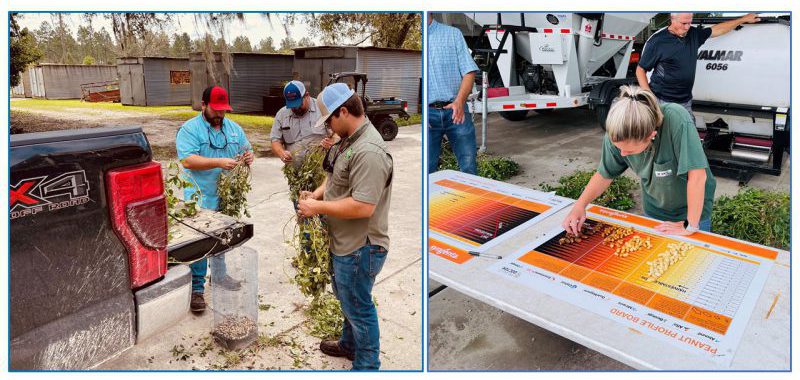
Determining optimum harvest timing via pod-blasting and a peanut maturity board will be essential this year. Don’t dig by the calendar. Photo Credit: De Broughton, UF/IFAS
The peanut growing season is winding down. In the Peninsular counties, lots of peanuts are already out of the field and here in the Panhandle harvest is coming on fast. The calendar says it’s time to dig mid-April planted peanuts, but peanuts don’t know how to read a calendar, so we’d better look a little harder at the situation. There are many factors that determine how rapidly peanuts mature with the two most important factors being heat and available moisture. Goodness knows we’ve had plenty of heat this summer, so many of our rain-fed fields have been severely lacking in available moisture for substantial portions of the growing season. Drought stress has most rain-fed fields in the Panhandle tracking behind schedule in terms of maturity.
Those of us in Extension say it every year, “don’t dig based solely on the calendar“. While this adage is always true, it is especially applicable ing years when our crop faces challenging growing conditions. Note: In this context, “the calendar” or “schedule” refers to assumption of maturity at 140 days after planting. Digging peanuts when the largest possible percentage of the pods in a field reach physiological maturity allows for both yield and grade to be maximized. Peanuts reach physiological maturity after the accumulation of approximately 2500 Growing Degree Days. The aGDD Tracker below shows the number of aGDDs accumulated by fields across a variety of locations and planting dates. To estimate the progress of your fields, find the closest represented location (columns) and the closest represented planting date (rows) and find the cell where the column and row intersect. If the aGDD value shown for your field is black (under 2300), it’s probably not time to dig. If it’s yellow (between 2300 and 2500), you’re getting close; it’s time to pull samples and pod-blast to fine tune your harvest timing. Orange (2500+) means it’s almost certainly time to harvest, but pod-blasting is always the best way to know for sure.
aGDD Tracker for the Florida Peanut Producing Region – 9/8/23 edition
The aGDD Tracker is compiled from data generated by PeanutFARM.org.
The dark blue bars in the cells with the aGDD values indicate progress towards 2500 aGDDs. The bar extends to the right as aGDDs are accumulated. The entire cell will be dark blue when a field has accumulated 2500 aGDDs.
It is recommended that fields be sampled and exact days-to-harvest be determined via pod-blasting once a field reaches 2300 aGDDs.
As you look over the aGDD Tracker, you can see tremendous differences in the number of accumulated aGDDs when you compare irrigated and rain-fed fields with the same location and planting date. In most cases, the irrigated fields are 300-500 aGDDs ahead of the rain-fed fields. With all the heat we’ve had this summer, heavily irrigated fields are likely tracking ahead of the calendar, while rain-fed fields are significantly behind. In both scenarios it is incredibly important this year to have good representative samples pod-blasted and let the maturity board help you optimize your harvest timing. This week, Agents in the central Panhandle have pod-blasted samples that were both both ahead and behind schedule. It’s going to be a tough year to know exactly when to dig, so take the time to make the most informed decision you can. Call your local Extension Office. Your County Agent is available to help you with this process, that’s what we’re here for.
- Peanut Maturity Update – 10/9/25 - October 10, 2025
- Fall Can be a Great Time for Vegetation Management - October 3, 2025
- Peanut Maturity Update – 9/25/25 Edition - September 26, 2025
